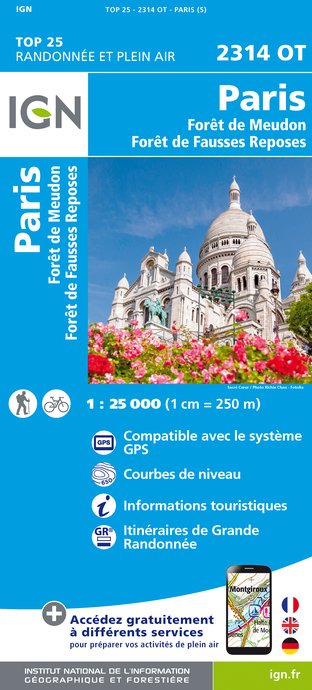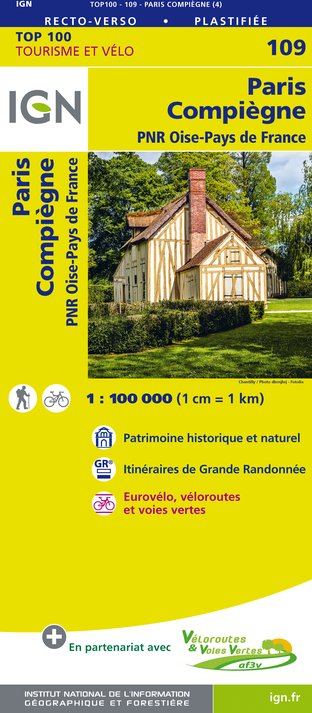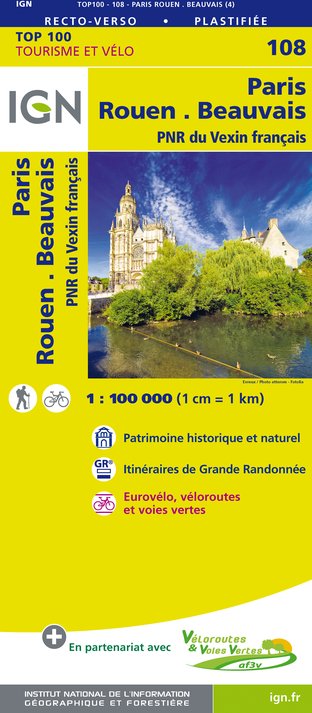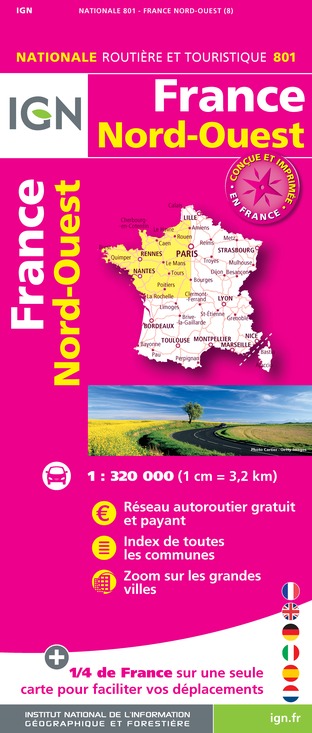Allarme
Allarmi
Tipo di pratica
A piedi
Presentazione
Mappa
Tappe
Punti di interesse
Sintesi di Cirkwi
Valutazioni e recensioni
Vedi nei dintorni
Le stemma di Parigi « Fluctuat nec mergitur »



Credito : Bluebear2
Il breve di Cirkwi
Scopri Parigi: Un Viaggio Storico Attraverso i Suoi Simboli
Come scrittore di una rivista di viaggi, sono entusiasta di presentarti un viaggio unico creato da Balades Fluviales Fabienne Lemoine Fondateur, che promette una esplorazione intima del ricco patrimonio di Parigi attraverso i suoi simboli iconici e le sue insegne. Questo viaggio non si tratta solo di ripercorrere i passi; si tratta di scoprire l'essenza dello spirito indomito di Parigi, ancorato al suo famoso motto "Fluctuat nec mergitur". Mentre ci immergiamo nei pittoreschi paesaggi e nelle meraviglie architettoniche che hanno resistito alla prova del tempo, scopriremo una narrazione di resilienza, prestigio ed onore incrollabile che il motivo della città racchiude. Unisciti a noi per vivere una fetta diversa di Parigi, lontano dai percorsi turistici ben battuti.
Un Viaggio di Caratteristiche Distintive
Questo itinerario meticolosamente elaborato da Balades Fluviales Fabienne Lemoine Fondateur si estende per circa 12,92 km, spostandosi da altitudini di 63 metri a minimi di 27 metri con una leggera variazione altimetrica che segnala un'escursione relativamente agevole che la maggior parte delle persone troverebbe gestibile. Il progetto accurato garantisce un flusso senza soluzione di continuità da un punto di riferimento all'altro senza sforzi superflui. I cambiamenti di altitudine positiva previsti oscillano tra i 109 e i 107 metri, indicando un'andatura dolce adatta a partecipanti di tutte le età, rendendolo un viaggio tecnicamente accessibile attraverso il cuore storico di Parigi.
Orientamenti Stagionali per gli Esploratori di Parigi
Ogni stagione a Parigi offre una scenografia unica per questo viaggio emblematico. In primavera, la città fiorisce, offrendo un contesto pittoresco ideale per l'esplorazione. L'estate porta giornate più lunghe, ma anche affluenza turistica maggiore; si consigliano visite di prima mattina o di tarda serata. L'autunno dipinge la città con tonalità calde, perfette per passeggiate rilassanti, mentre l'inverno, sebbene più freddo, spesso offre giornate più limpide. Indipendentemente dalla stagione, è imprescindibile indossare scarpe comode da passeggio e prepararsi sempre per le imprevedibili piogge della città con un ombrello o un impermeabile per garantire un'esplorazione piacevole ed ininterrotta.
Il Cuore della Storia e della Cultura Francese
Parigi, nella sua essenza, non è solo la capitale della Francia ma il fulcro della sua evoluzione storica e culturale, profondamente intrecciata con l'identità della nazione. La città, storicamente un centro per studiosi, artisti e rivoluzionari, vanta un'eredità che si estende per secoli. Gli stemmi e i simboli che incontrerai racchiudono storie di resilienza, rivoluzione e rinascita che hanno plasmato non solo la città ma anche la nazione. Mentre percorriamo questo percorso, non stiamo solo ammirando meraviglie architettoniche, ma stiamo entrando in una narrazione viva e pulsante di ingegno e spirito umano che continua ad influenzare il mondo.
Informazioni Meteo per l'Avventuriero Parigino
Il clima di Parigi è prevalentemente oceanico, caratterizzato da inverni miti e estati piacevolmente calde, rendendolo una destinazione da visitare tutto l'anno. Tuttavia, il momento migliore per intraprendere questo viaggio emblematico sarebbe durante la primavera (da marzo a maggio) o l'autunno (da settembre a novembre). In questi periodi le temperature sono generalmente miti e ci sono meno turisti, offrendo un'esperienza più rilassata della ricca trama di storia e cultura della città. Controlla sempre le previsioni del tempo prima del tuo viaggio, poiché Parigi è nota per le sue piogge impreviste, indipendentemente dalla stagione.
Come scrittore di una rivista di viaggi, sono entusiasta di presentarti un viaggio unico creato da Balades Fluviales Fabienne Lemoine Fondateur, che promette una esplorazione intima del ricco patrimonio di Parigi attraverso i suoi simboli iconici e le sue insegne. Questo viaggio non si tratta solo di ripercorrere i passi; si tratta di scoprire l'essenza dello spirito indomito di Parigi, ancorato al suo famoso motto "Fluctuat nec mergitur". Mentre ci immergiamo nei pittoreschi paesaggi e nelle meraviglie architettoniche che hanno resistito alla prova del tempo, scopriremo una narrazione di resilienza, prestigio ed onore incrollabile che il motivo della città racchiude. Unisciti a noi per vivere una fetta diversa di Parigi, lontano dai percorsi turistici ben battuti.
Un Viaggio di Caratteristiche Distintive
Questo itinerario meticolosamente elaborato da Balades Fluviales Fabienne Lemoine Fondateur si estende per circa 12,92 km, spostandosi da altitudini di 63 metri a minimi di 27 metri con una leggera variazione altimetrica che segnala un'escursione relativamente agevole che la maggior parte delle persone troverebbe gestibile. Il progetto accurato garantisce un flusso senza soluzione di continuità da un punto di riferimento all'altro senza sforzi superflui. I cambiamenti di altitudine positiva previsti oscillano tra i 109 e i 107 metri, indicando un'andatura dolce adatta a partecipanti di tutte le età, rendendolo un viaggio tecnicamente accessibile attraverso il cuore storico di Parigi.
Orientamenti Stagionali per gli Esploratori di Parigi
Ogni stagione a Parigi offre una scenografia unica per questo viaggio emblematico. In primavera, la città fiorisce, offrendo un contesto pittoresco ideale per l'esplorazione. L'estate porta giornate più lunghe, ma anche affluenza turistica maggiore; si consigliano visite di prima mattina o di tarda serata. L'autunno dipinge la città con tonalità calde, perfette per passeggiate rilassanti, mentre l'inverno, sebbene più freddo, spesso offre giornate più limpide. Indipendentemente dalla stagione, è imprescindibile indossare scarpe comode da passeggio e prepararsi sempre per le imprevedibili piogge della città con un ombrello o un impermeabile per garantire un'esplorazione piacevole ed ininterrotta.
Il Cuore della Storia e della Cultura Francese
Parigi, nella sua essenza, non è solo la capitale della Francia ma il fulcro della sua evoluzione storica e culturale, profondamente intrecciata con l'identità della nazione. La città, storicamente un centro per studiosi, artisti e rivoluzionari, vanta un'eredità che si estende per secoli. Gli stemmi e i simboli che incontrerai racchiudono storie di resilienza, rivoluzione e rinascita che hanno plasmato non solo la città ma anche la nazione. Mentre percorriamo questo percorso, non stiamo solo ammirando meraviglie architettoniche, ma stiamo entrando in una narrazione viva e pulsante di ingegno e spirito umano che continua ad influenzare il mondo.
Informazioni Meteo per l'Avventuriero Parigino
Il clima di Parigi è prevalentemente oceanico, caratterizzato da inverni miti e estati piacevolmente calde, rendendolo una destinazione da visitare tutto l'anno. Tuttavia, il momento migliore per intraprendere questo viaggio emblematico sarebbe durante la primavera (da marzo a maggio) o l'autunno (da settembre a novembre). In questi periodi le temperature sono generalmente miti e ci sono meno turisti, offrendo un'esperienza più rilassata della ricca trama di storia e cultura della città. Controlla sempre le previsioni del tempo prima del tuo viaggio, poiché Parigi è nota per le sue piogge impreviste, indipendentemente dalla stagione.
Generato automaticamente.
IGN Carte

2314OT - PARIS FORÊT DE MEUDON FORÊT DE FAUSSES REPOSES
Editore : IGN
Collezione : TOP 25 ET SÉRIE BLEUE
Scala : 1:25 000
13.90€

119 PARIS SENS PNR DU GÂTINAIS FRANÇAIS
Editore : IGN
Collezione : TOP 100
Scala : 1:100 000
8.40€

190 PARIS CHANTILLY FONTAINEBLEAU
Editore : IGN
Collezione : TOP 100
Scala : 1:100 000
8.40€

118 PARIS CHARTRES PNR DE LA HAUTE VALLÉE DE CHEVREUSE
Editore : IGN
Collezione : TOP 100
Scala : 1:100 000
8.40€

109 PARIS COMPIÈGNE PNR OISE-PAYS DE FRANCE
Editore : IGN
Collezione : TOP 100
Scala : 1:100 000
8.40€

108 PARIS ROUEN BEAUVAIS PNR DU VEXIN FRANÇAIS
Editore : IGN
Collezione : TOP 100
Scala : 1:100 000
8.40€

D75-95 ÎLE-DE-FRANCE OUEST
Editore : IGN
Collezione : CARTES DÉPARTEMENTALES IGN
Scala : 1:150 000
5.90€

D77 SEINE-ET-MARNE
Editore : IGN
Collezione : CARTES DÉPARTEMENTALES IGN
Scala : 1:150 000
5.90€

NR08 CENTRE-VAL DE LOIRE
Editore : IGN
Collezione : CARTES RÉGIONALES IGN
Scala : 1:250 000
6.80€

NR03 ÍLE DE FRANCE
Editore : IGN
Collezione : CARTES RÉGIONALES IGN
Scala : 1:250 000
6.80€

NR01 HAUTS-DE-FRANCE
Editore : IGN
Collezione : CARTES RÉGIONALES IGN
Scala : 1:250 000
6.80€

801 FRANCE NORD OUEST
Editore : IGN
Collezione : CARTES NATIONALES IGN
Scala : 1:320 000
6.10€

EUROPE
Editore : IGN
Collezione : DÉCOUVERTE DES PAYS DU MONDE IGN
Scala : 1:2 500 000
7.00€
Informazioni tecniche
A piedi
Difficoltà
Non specificata
Dist.
13 km
Tipo di pratica
A piedi
Mostra di più
Profilo altimetrico
Punto di partenza
75004
Paris
Lat : 48.856414Lng : 2.3517394
Tappe
Punti di interesse
Autore dei dati
Valutazioni e recensioni
Da vedere nei dintorni










